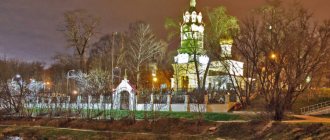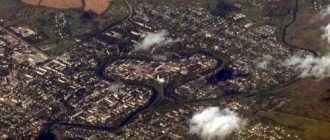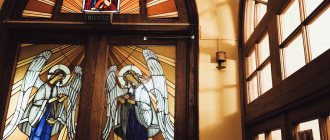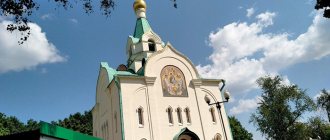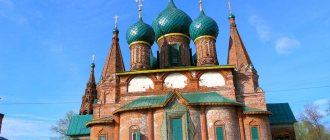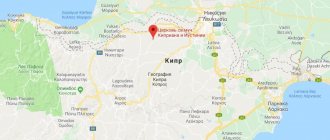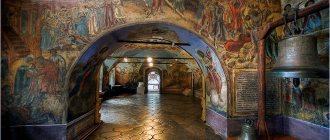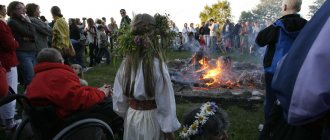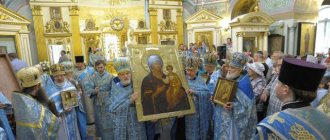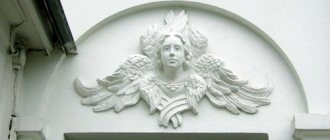Mir
Russia Moscow Temple of the Apostle John the Theologian near Elm (Moscow) Map is loading...
{"format":"leaflet","minzoom":false,"maxzoom":false,"limit":50,"offset":0,"link":"all","sort":[""], "order":[],"headers":"show","mainlabel":"","intro":"","outro":"","searchlabel":"\u2026 \u0441\u043b\u0435\ u0434\u0443\u044e\u0449\u0438\u0435 \u0440\u0435\u0437\u0443\u043b\u044c\u0442\u0430\u0442\u044b","default":"","import-annotation":false,"width ":"auto","height":"350px","centre":{"text":"","title":"""link":"""lat":55.75759500000000201680450118146836757659912109375,"lon": 37.6278429999999985966496751643717288970947265625,"icon":""},"title":"","label":"","icon":"","lines":[],"polygons":[],"circles":[ ],"rectangles":[],"copycoords":false,"static":false,"zoom":8,"defzoom":14,"layers":["OpenStreetMap"],"image layers":[] ,"overlays":[],"resizable":false,"fullscreen":true,"scrollwheelzoom":true,"cluster":false,"clustermaxzoom":9,"clusterzoomonclick":true,"clustermaxradius":80, "clusterspiderfy":true,"geojson":"","clicktarget":"","showtitle":true,"hidenamespace":false,"template":"","userparam":"","activeicon": "","pagelabel":false,"ajaxcoordproperty":"","ajaxquery":"","locations":[{"text":"\u003Cb\u003E\u003Ca href=\"/palomnik/%D0% A5%D1%80%D0%B0%D0%BC_%D0%B0%D0%BF%D0%BE%D1%81%D1%82%D0%BE%D0%BB%D0%B0_%D0%98% D0%BE%D0%B0%D0%BD%D0%BD%D0%B0_%D0%91%D0%BE%D0%B3%D0%BE%D1%81%D0%BB%D0%BE%D0% B2%D0%B0_%D0%BF%D0%BE%D0%B4_%D0%92%D1%8F%D0%B7%D0%BE%D0%BC_(%D0%9C%D0%BE%D1%81 %D0%BA%D0%B2%D0%B0)\» title=\»\u0425\u0440\u0430\u043c \u0430\u043f\u043e\u0441\u0442\u043e\u043b\u0430 \u0418\u043e\u0430\ ( u041c\u043e\u0441\u043a\u0432 \u0430)\»\u003E\u0425\u0440\u0430\u043c \u0430\u043f\u043e\u0441\u0442\u043e\u043b\u0430 \u0418\u043e\u0430\u043d\u043d\u04 30\u0411\u043e\u0433\ u043e\u0441\u043b\u043e\u0432\u0430 \u043f\u043e\u0434 \u0412\u044f\u0437\u043e\u043c (\u041c\u043e\u0441\u043a\u0432\u0430)\ u003C/a\u003E\u003C/ b\u003E\u003Chr /\u003E\u003Ca href=\"/palomnik/%D0%A1%D0%B2%D0%BE%D0%B9%D1%81%D1%82%D0%B2%D0%BE: %D0%90%D0%BD%D0%BD%D0%BE%D1%82%D0%B0%D1%86%D0%B8%D1%8F\" title=\"\u0421\u0432\u043e\u0439 \u0441\u0442\u0432\u043e:\u0410\u043d\u043d\u043e\u0442\u0430\u0446\u0438\u044f\u003E\u0410\u043d\u043d\u043e\u0442\u0430 \u0446\u0438\u044f\ u003C/a\u003E: 16 \u0441\u0435\u043d\u0442\u044f\u0431\u0440\u044f 2010 \u0433\u043e\u0434\u0430 \u041f\u0430\u0442\u0440\u0 438\u0430\u0440\u0445\u041c \u043e\u0441\u043a\u043e\u0432\u0441\u043a\u0438\u0439 \u003Cspan class=\»smw-highlighter\» data-type=\»2\» data-state=\»persistent\» data-title =\"\u0418\u043d\u0444\u043e\u0440\u043c\u0430\u0446\u0438\u044f\" title=\"16 \u0441\u0435\u043d\u0442\u044f\u0431\u0440\u044f 201 0\u0433\ u043e\u0434\u0430 \u041f\u0430\u0442\u0440\u0438\u0430\u0440\u0445 \u041c\u043e\u0441\u043a\u043e\u0432\u0441\u043a\u0438\u0 439\u0438\u0432\u0441\u0435\ u044f \u0420\u0443\u0441\u0438 \u041a\u0438\u0440\u0438\u043b\u043b \u0441\u0432\u043e\u0438\u043c \u0443\u043a\u0430\u0437\ u043e\u043c\u043f\u0440\u0435\ u0434\u043e\u0441\u0442\u0430\u0432\u0438\u043b \u0437\u0434\u0430\u043d\u0438\u0435 \u0445\u0440\u0430\u043c\u0430 \u0441 \ u043f\u0440\u0438\u043b\u0435\ u0433\u0430\u044e\u0449\u0438\u043c\u0438 \u043f\u0440\u0438\u0445\u043e\u0434\u0441\u043a\u0438\u043c\u0438 \u0441\u0442\u0 440\u043e\u0435\u043d\u0438\ u044f\u043c\u0438 \u0420\u043e\u0441\u0441\u0438\u0439\u0441\u043a\u043e\u043c\u0443 \u043f\u0440\u0430\u0432\u043e\u0441\u0 43b\u0430\u0432\u043d\u043e\ u043c\u0443 \u0438\u043d\u0441\u0442\u0438\u0442\u0443\u0442\u0443 \u0445\u0440\u0430\u043c \u0418\u043e\u0430\u043d\u043d\u 0430\u0411\u043e\u0433\u043e\ u0441\u043b\u043e\u0432\u0430 \u00ab\u0434\u043b\u044f \u0431\u043e\u0433\u043e\u0441\u043b\u0443\u0436\u0435\u0431\u043d\u04 3e\u0439,\u043f\u0440\u043e \u0441\u0432\u0435\u0442\u0438\u0442\u0435\u043b\u044c\u0441\u043a\u043e\u0439 \u0438 \u0441\u043e\u0446\u0438\u0430\u043b\ u044c\u043d\u043e\u0439\u0434 \u0435\u044f\u0442\u0435\u043b\u044c\u043d\u043e\u0441\u0442\u0438\u00bb.\»\u003E\u003Cspan class=\»smwtext\»\u003E \u2026 \u003C/span\u 003E\u003Cspan class=\"smwttcontent\"\u003E16 \u0441\u0435\u043d\u0442\u044f\u0431\u0440\u044f 2010 \u0433\u043e\u0434\u0430 \u041f\u0430\u0442\u0440 \u0438\u0430\u0440\u0445 \u041c\u043e\u0441\u043a\u043e\u0432\u0441\u043a\u0438\u0439 \u0438 \u0432\u0441\u0435\u044f \u0420\u0443\u0441\u0438 \u041 a\u0438\u0440\u0438\u043b\u043b \u0441\u0432\u043e\u0438\u043c \u0443\u043a\u0430\u0437\u043e\u043c \u043f\u0440\u0435\u0434\u043e\u0441\u0442\u0430\u0432\ u0438\u043b\u0437\u0434\u0430 \u043d\u0438\u0435 \u0445\u0440\u0430\u043c\u0430 \u0441 \u043f\u0440\u0438\u043b\u0435\u0433\u0430\u044e\u0449\u0438\u043c \u0438 \u043f\u0440\u0438\u0445 \u043e\u0434\u0441\u043a\u0438\u043c\u0438 \u0441\u0442\u0440\u043e\u0435\u043d\u0438\u044f\u043c\u0438 \u0420\u043e\u0441\ u0441\u0438\u0439\u0441\u043a \u043e\u043c\u0443 \u043f\u0440\u0430\u0432\u043e\u0441\u043b\u0430\u0432\u043d\u043e\u043c\u0443 \u0438\u043d\u0441\u0442\ u0438\u0442\u0443\u0442\u0443 \u0445\u0440\u0430\u043c \u0418\u043e\u0430\u043d\u043d\u0430 \u0411\u043e\u0433\u043e\u0441\u043b\u043e\u0432\u0430 \u00ab\ u0434\u043b\u044f\u0431\u043e \u0433\u043e\u0441\u043b\u0443\u0436\u0435\u0431\u043d\u043e\u0439, \u043f\u0440\u043e\u0441\u0432\u0435\u0442\u0438\u0442\ u0435\u043b\u044c\u0441\ u043a\u043e\u0439 \u0438 \u0441\u043e\u0446\u0438\u0430\u043b\u044c\u043d\u043e\u0439 \u0434\u0435\u044f\u0442\u0435\u043b\u 044c\u043d\u043e\u0441\u0442\ u0438\u00bb.\u003C/span\u003E\u003C/span\u003E\u043e\u0441\u0432\u0435\u0442\u0438\u0442\u0435\u043b\u044c\u0441\u043a\u043e\u043 9\u0438\u0441\u043e \u0446\u0438\u0430\u043b\u044c\u043d\u043e\u0439 \u0434\u0435\u044f\u0442\u0435\u043b\u044c\u043d\u043e\u0441\u0442\u0438\u 00bb.","title":" \u0425\u0440\u0430\u043c \u0430\u043f\u043e\u0441\u0442\u043e\u043b\u0430 \u0418\u043e\u0430\u043d\u043d\u0430 \u0411\u043e \u0433\u043e\u0441\u043b\u043e \u0432\u0430 \u043f\u043e\u0434 \u0412\u044f\u0437\u043e\u043c (\u041c\u043e\u0441\u043a\u0432\u0430)»»link»:»»»lat»:55.757595000 00000201680450118146836757659912109375," lon":37.6278429999999985966496751643717288970947265625,"icon":""}],"imageLayers":[]}
55.757551; 37.627822
Russia, Moscow, New Square, 12
Moscow
Russia
Phones:
(495) 626-22-25, +7 (495) 6262156
Church of the Holy Apostle John the Evangelist under Elm
(St. John the Theologian Church at the Kitai-Gorod Wall) is an Orthodox church of the Iveron deanery of the Moscow city diocese; in 1934-2011 the Museum of Moscow was located here. On September 16, 2010, Patriarch Kirill of Moscow and All Rus', by his decree, provided the church building with adjacent parish buildings to the Russian Orthodox Institute, the Church of St. John the Theologian “for liturgical, educational and social activities.”
History[edit]
The Church of the Holy Apostle John the Theologian appeared in 1493, first wooden, then stone, rebuilt several times. The current building was built according to the design of architects S. P. Obitaev and L. P. Carloni in 1825-1837.
The name “Under the Elm” comes from a huge elm tree that grew in front of the altar back in the time of Catherine II.
In 1925 the temple was closed. Since 1934, it has housed the Museum of the Capital. The onion domes above the temple and bell tower were dismantled, and interfloor ceilings were installed in the interior.
In 1992, a decree of the Moscow Government was issued, according to which the temple was transferred to the Russian Orthodox Church for free use; The Museum of the History of Moscow, which occupied these premises, had nowhere to move. At the same time as believers demanded that the temple be given back, Muscovites spoke out against moving the museum from the very center of the city. In 2006, the museum was given the “Provision Warehouses” complex on Zubovsky Boulevard (architect Vasily Stasov), its renovation and adaptation for organizing exhibitions took two years.
On September 16, 2010, Patriarch Kirill of Moscow and All Rus', by his decree, provided the church building with adjacent parish buildings to the Russian Orthodox Institute, the Church of St. John the Theologian “for liturgical, educational and social activities.”
The premises were transferred to the church in 2011; On October 9, for the first time in a long time, the Divine Liturgy took place in the church.
In the temple, along with divine services, various events are held.
Church of St. John the Evangelist
Church of St. John the Evangelist in Bronnaya Sloboda on Tverskoy Boulevard
The Church of St. John the Evangelist in Bronnaya Sloboda on Tverskoy Boulevard has been known since 1625 and was founded under the Romanovs. It contained an ancient icon of St. Evangelist John the Theologian, donated by Tsar Mikhail Fedorovich.
The area is named after the ancient settlement of armor workers located here at that time - master gunsmiths who made weapons and armor. Later, the name “armor workers” remained only for those craftsmen who made only armor: helmets, chain mail, and shells. Slobozhans were rich, and in 1652, “through the diligence of the parish people,” a new, large and beautiful stone church was erected, which has survived to this day.
Since the middle of the 19th century, the area of Tverskoy Boulevard and especially the famous Kozikha (so named because in the old days the goats of the Patriarchal Sloboda grazed here) were chosen by Moscow students. The area between both Bronnaya streets and Palashevsky Lane was even called the “Latin Quarter” of Moscow - poor students lived here. They considered Kozikha, traditional for students, “native”, and settling there was a matter of honor for them. On the left side of Malaya Bronnaya Street stood the former houses of Hirsch with cheap apartments for rent, which were rented by students (house No. 13 has been preserved). On Bolshaya Bronnaya and Kozikha there were also two houses owned by the Chebyshevs - “Chebyshev Fortress” or “Chebyshi” - with student apartments, as they would now say, like dormitories.
Four people lived in each room, sometimes with only two pairs of boots and dresses between four of them. In clothes, they took turns going to lectures at the university: two sat on Mokhovaya and recorded lectures, two in the room waited for them and prepared a modest lunch, and the next day they changed. Instead of tea, which, by the way, was very useful for students, they often drank cheap chicory - according to recollections, one round stick was enough for four people for 10 days.
And since not all students could afford apartments, the “homeless people” spent the night right on Tverskoy Boulevard in the warm season. So, the Church of St. John the Evangelist turned out to be the very center of student free life that was in full swing in this area of Moscow.
There is one noisy quarter in the capital Moscow - It is called Kozikha Bolshoi. From dawn to dawn As soon as the lanterns are lit, a line of students stagger, And Ivan the Theologian looks at them without words From his bell tower he smiles
This student song was often sung in Moscow. They say that this was our Moscow version of the song of the Kyiv students, where St. Vladimir is replaced by St. John the Theologian.
Until 1884, students did not have a uniform, and they dressed freely, according to the latest chic student fashion of the freedom-loving 60s: especially “radical” ones wore long hair, a wide-brimmed hat pulled down over their eyes, a plaid on their shoulders and glasses, which gave them seriousness and a respectable, scholarly appearance. The new university charter of 1884 destroyed professorial autonomy, doubled tuition fees and introduced compulsory student uniforms: uniforms, frock coats, coats with coat of arms buttons and caps with blue bands. Then it became fashionable to wear a shabby cap and an unbuttoned frock coat. This form of clothing expressed the idea of students - free, daring, desperate...
By the way, V.O. himself lived in Bolshoi Kozikhinsky Lane when he was a student. Klyuchevsky.
Church of St. John the Evangelist in Bronnaya Sloboda on Tverskoy Boulevard
On October 9, 1892 (new style), on the feast of St. John the Theologian, Marina Tsvetaeva was born in Moscow, who lived her entire childhood not far from this church in Trekhprudny Lane.
The rowan tree lit up with a red brush. The leaves were falling, I was born. Hundreds of Bells Argued. It was Saturday, John the Theologian. To this day I still want to gnaw the red brush of the hot rowan.
In this “dispute” of bells there was also the voice of the Church of St. John the Evangelist from Tverskoy Boulevard.
The removal of church valuables from the temple in 1922 was observed by O.E. Mandelstam and his wife, who recorded what they saw: “We entered the church, and no one stopped us. The priest, elderly, disheveled, was trembling all over, and large tears were rolling down his face when they tore off his vestments and threw the icons right on the floor. Those who carried out the confiscation carried out noisy anti-religious propaganda, accompanied by the cries of old women and the hooting of the crowd, enjoying the unprecedented spectacle. The church, as you know, is a superstructure, and it was destroyed along with the previous basis.”
In 1932, the Moscow City Chamber Theater (named after Pushkin) petitioned for the demolition of the temple, but the architect D.P. Sukhov opposed it, and then only the church domes and the drum itself were destroyed. Then theater workshops, a scenery warehouse and a carpentry shop were located inside.
In the early 70s, the slow restoration of the temple began: the bell tower was repaired and a cross was made from a photograph from Naydenov’s album. However, construction work was carried out intermittently; there were not enough funds or builders. They said that once M.A. Suslov, the main ideologist of the Communist Party, who lived next to the church on Bolshaya Bronnaya Street, was walking near the house and drew attention to the dilapidated church, which had been restored for a long time and could not be completed. There was one call from him to the Ministry of Culture - and funds, materials, and builders appeared. Only Suslov’s intervention was limited to just this one call, and the restoration work soon came to a standstill again.
Back in the 90s, the church building was scary with its cracks gaping across the entire wall. It turned out that in 1985, a pit was opened near the western wall of the refectory to examine the foundation, and the water that got under the foundation led to the appearance of these deep cracks. Then it seemed that the condition of the temple was hopeless, although services had resumed there since 1992.
Temple of St. John the Evangelist, “under the Elm, near the Chinese Wall”
Another famous Moscow Church of St. John the Evangelist, “which is under the Elm, near the Chinese Wall,” is located on New Square near Lubyanka, directly opposite the Polytechnic Museum. The onion dome and the cross on it have not survived, and on the pediment there is the inscription “1825” - the time of its foundation. The name “Under the Elm” comes from a huge elm tree that once grew in front of the altar during the time of Catherine the Great. Until 1934, the wall of Kitay-Gorod ran next to the temple, and this is also reflected in the name.
The church appeared here back in 1493, first wooden, then stone, rebuilt several times. The current one was consecrated in 1837.
From 1934 to the present time, the Museum of History and Reconstruction of Moscow has been housed in the building of the former church. Previously, he was located in the Sukharev Tower and was transferred from there when the tower was demolished. There have been various projects for transferring the museum (moreover, from a rather cramped building for it) to other, more suitable premises, for example, to the building of the Novo-Ekaterininskaya Hospital on Strastnoy Boulevard (with the relocation of the hospital), but so far all of them have not been resolved.
During the October Revolution in Russia, the Church of St. John the Evangelist was deprived of land and church utensils
But in 1922, the temple lost its land plot and all its valuables due to the October Revolution.
This is exactly what the temple looked like during the October Revolution in Russia in 1922
Many people remember these terrible times. This time was also marked by persecution of Christians for their faith.
At the same time, the first new martyrs appeared in the church. There were such ones in the Church of St. John the Evangelist.
New Martyr of the Church of St. John the Theologian - Nikolai Dobrolyubov, suffered for his faith in Christ during the terrible persecution of Christians
In 1914, a Chamber Theater was built next to the temple. Its leaders proposed demolishing the temple. But they only managed to demolish the domes and the drum. Afterwards, the church building was given over to the needs of the theater. They destroyed the main altar, drums, paintings, and the temple fence.
Afterwards, there was a dormitory in the temple, and then machines for work were installed in it.
At the end of the 17th century, you could meet many famous people on Bronnaya
Somewhere at the end of the 17th century, one could meet a lot of famous people from the Moscow elite on Bronnaya Svoboda.
For example, Auditor General Prince Andrei Fedorovich Shakhovsky, Prince Ivan Baryatinsky, nobles Musina-Pushkina and many others. All of them became parishioners in local suburban churches.
Auditor General Prince Andrei Fedorovich Shakhovsky - Patriarchal Steward, Solicitor, Okolnichy and Voivode. At the end of the 17th century he often visited Bronnaya Svoboda
The Church of St. John the Evangelist was also not left without its parishioners. In 1690, Ivan Fedorovich Motorin cast a new bell especially for the temple by order.
Ivan Fedorovich Motorin is a Russian foundry worker, bell and artillery master. He cast a new bell especially for the Church of St. John the Evangelist
Schedule of services
The Cathedral of St. John the Evangelist in New York holds services daily, with more than 30 services per week. Starting times vary depending on the day of the week:
- Mon-Sat : 08:30, 17:30;
- Sun : 08:00, 09:00, 11:00. Choral Evensong - 16:00.
The Cathedral of St. John the Evangelist in New York organizes baptisms, weddings, and farewells to the departed. The Episcopal Church is known for performing same-sex marriage ceremonies.
You can also attend concerts and other cultural events here. You can find out about all current events in the calendar on the website of the Church of St. John the Evangelist.
The cathedral is open to tourists from Monday to Friday from 09:30 to 15:00, on Saturdays and Sundays from 09:30 to 17:00. To attend services, you can come here any day from 07:30 to 18:00.
© Alexia K.
BEFORE ENTRANCE TO THE TEMPLE
· Before making a bow, you need to make the sign of the cross and then make a bow - if it’s small, then you need to bow your head so that you can reach the ground with your hand; with a great (earthly) bow, you need to bend both knees together and reach the ground with your head. · The sign of the cross should be depicted on oneself correctly, with reverence, slowly, joining together the first three fingers of the right hand as a sign that God is the One and Equal Trinity, and the remaining two fingers folded and bent to the palm in commemoration of the fact that Jesus Christ there is God and man who came to our earth for the sake of salvation. The right hand (right hand) folded in this way should be placed first on the forehead, so that the Lord will enlighten our mind, then on the belly, in order to tame the flesh that wars on the spirit and sanctify our feelings, and then on the right and left shoulders - to sanctify our bodily strength. Then say a short prayer: God, be merciful to me, a sinner (bow). God, cleanse me, a sinner, and have mercy on me (bow). Who created me, Lord, forgive me! (bow).
IN THE TEMPLE Before the service · You must come to the temple at the very beginning of the service. If the service has begun, stand in a certain place and listen intently to the readings and chants. You should not shake hands with your acquaintances - greet them with a silent bow, do not talk or move from place to place during the service. · There is a pious rule to come to the Liturgy on an empty stomach, even if one does not receive communion that day. · Upon entering the temple, it is customary to venerate the “festive” icon lying on the lectern in the middle of the church and make small bows before the icons of the Lord Jesus Christ, the Most Holy Theotokos and the saints (if the service has not begun at this time). Before the service begins, you can light candles in front of one image or another, which are purchased at the entrance in a “candle box” - this is our small contribution - a sacrifice to the Church. · You should not pass between the Royal Doors and the lectern, but when you pass in front of the lectern, make a small bow, making the sign of the cross. · By being late for the start of the service or leaving before its end, a person shows disrespect for the Sacrament. In case of emergency, you can leave, but not while reading the Gospel and celebrating the Eucharist.
The first wooden temple is believed to have been built in the 70s of the 16th century
It is unknown when the temple was built. According to assumptions, the first wooden church of St. John the Evangelist on Bronnaya Svoboda arose in the 70s of the 16th century.
At the beginning of the 17th century, a time of troubles began, which greatly affected the residents of Bronnaya Svoboda. On March 19, 1611, a popular riot broke out in Moscow.
The Poles decided to set fire to the city from all ends. Slobodsk residents left their burnt houses.
Almost all documents, including church ones, were destroyed in the fire.
Therefore, there are no documents about the exact date of construction of the Church of St. John the Evangelist.
Tsar Mikhail Fedorovich restored the burned and completely plundered country. Many crafts began to be revived, trade revived, and construction began. Gradually, Bronnaya freedom began to recover after troubled times.
Tsar Mikhail Fedorovich is the first Russian Tsar from the Romanov dynasty. Donated to the temple an icon of the Byzantine letter of John the Evangelist
In 1615, Tsar Mikhail Fedorovich gave the temple an icon of the Byzantine letter of the holy apostle and evangelist John the Theologian with his dedicatory signature. It was this icon that became one of the main shrines in the temple.
By the middle of the 17th century, representatives of more elite strata began to live on the territory of the former settlements. They begin construction on the site of a wooden church - a stone temple in the name of John the Evangelist in 1652.
1652
this year a stone temple is being erected instead of a burnt wooden one
The construction of the temple began in the era of Russian patterns. Russian patterning is an architectural style that was formed in the 17th century on the territory of the Russian state. It was characterized by intricate shapes, abundance of decor, complexity of its composition and picturesque silhouette.
And the construction of the temple ended during the era of reform of Patriarch Nikon. This was a newer style in temple architecture.
The Church of St. John the Evangelist was built according to the models of old and new canons of church architecture. It was also considered one of the best examples of that period.
The interior decoration of the temple required large material resources.
But it was not possible to collect income from local residents.
Then the parishioners were forced to turn to Tsar Alexei Mikhailovich himself for help. They wrote a collective petition in which they asked the king to donate church utensils to the temple, which were necessary for the performance of the divine liturgy.
The king supported the people and sent everything they needed.
In 1667, a Slavic-Greek school was opened at the temple.
At that time, many came to the conclusion that it was necessary to open schools in which Greek and Slavic languages were studied in order to avoid a schism in the Russian Orthodox Church.
In 1667, at the Church of St. John the Evangelist, an attempt was made to create a Slavic-Greek school in Bronnaya Svoboda.
But the curriculum of these schools had to go beyond the curriculum of ordinary schools, due to deepening into various languages. With all this, the initiators of such institutions were not only church people, but also secular ones.
In 1667 there were 2 petitions. One was addressed to Tsar Alexei Mikhailovich, the second was sent to the Tsar’s confessor, Archpriest Andrei Savinov. Each of the letters asked for patronage in the establishment of educational schools.
Also, for such a charitable cause, a petition for help was submitted to the three patriarchs. Where did the positive response come from almost immediately, with a blessed letter about the construction of the school from the primates of the three churches.
The charter also stated that the clergy should begin to use examples of Greek vestments, and that the choir should be given permission to sing in Greek.
1669
this year Ivan Andreevich Shmatkovsky became the new rector of the church
Until that moment, he was the archpriest of the Trinity Cathedral in the city of Glukhov.
Such a strange move of him to Moscow was not at all accidental. He was the only person who was close to the court. He attended receptions of the patriarch and communicated with representatives of the highest clergy. It was he who was entrusted with the creation and opening of a school at the Church of St. John the Evangelist.
No documents about the activities of this school have survived to this day.
But they say that all such schools at churches were closed by the beginning of the 1670s.
And Father John Shmatkovsky himself was the rector of the Church of St. John the Evangelist for only a short time. By the end of 1671, a new rector was appointed to the temple.
There is only one record about the existence and life of the school at the temple, about one singer - Ivan Fedorovich Volosheinov. He worked at the school as a teacher.
Prices
Entrance to the cathedral is free for those who come to worship or pray. In other cases, you will need to pay to visit the church; the ticket price depends on the category of visitors:
- adults - $10;
- preferential categories: students over 12 years old, pensioners - $8.
Reduced prices are offered for organized groups:
- adults - $8;
- preferential categories - $6.
When planning your visit, please note that the upper floors can only be accessed on a guided tour. The following types of excursions :
- Main : held from Monday to Friday at 11:00 and 13:00, and on Saturday at 11:00. Price - $15 / $12 for adults / discounted groups. During the tour, you will learn about the history and architectural features of the cathedral. Duration - 1 hour.
- Vertical tour : Mondays at 10:00, Wednesdays at 12:00, Fridays at 12:00, Saturdays at 12:00 and 14:00. Price – $20 / $18 for adults/beneficiaries. Persons under 12 years of age are not allowed. Duration - 1 hour. It's a 124-foot (about 38 m) journey up a spiral staircase to the top of the cathedral. The guide will tell you about the stained glass windows, sculpture and architecture of the church. At the end of the program, visitors go to the roof, which offers a beautiful view of Manhattan. Pre-registration is required by phone: (866) 811–4111.
- Special Tour : $18 / $15 for adults/discounted groups. Participants of the excursion will get acquainted with the unique architectural solutions of the structure, and will also discover the most interesting places of the cathedral. Reservations required.
Entrance tickets as well as guided tours can be purchased online or on site.
Prices for entrance tickets to the Cathedral of St. John the Evangelist in New York
Tickets and tours to the Cathedral of St. John the Evangelist Buy at
Buy a ticket for a tour of the Cathedral of St. John the Evangelist Buy at
© Vladimir Gorodzeisky
In 1837, a new second chapel was built in the name of Mitrofan of Voronezh
From 1837 to 1838, construction began on a new second chapel in the Church of St. John the Evangelist in the name of Mitrofan of Voronezh.
During these years, repairs were also made, after which the temple was consecrated by St. Philaret of Moscow.
Saint Philaret of Moscow is a bishop of the Orthodox Russian Church. After the construction of the second chapel in the Church of St. John the Evangelist on Bronnaya, it was consecrated by St. Philaret
The chapel in the name of Mitrofan of Voronezh was moved from the middle of the temple to the right apse of the St. John the Theologian altar.
In 1876, master carver Andrei Khomyakov made a new iconostasis for the main part of the temple. It was very beautifully painted and decorated. You can only see it in the temple itself.
XIX
in this century, oven heating was installed and heated floors were built
There was a parochial school at the temple.
In 1917, the temple had a large plot of land with a courtyard and garden. There were 4 houses on church land, some of the apartments were occupied by clergy and church workers. Behind the temple altars there was a cemetery.
Also in the temple, in addition to the shrine donated by Mikhail Fedorovich, there was a miraculous icon of the Mother of God “Tenderness”.
Architecture
The cathedral is also a historical landmark in New York. Construction of the church on the hill began in 1892, on St. John's Day. The design by architects D. L. Haynes and C. G. LaFarge combined Romanesque and Byzantine architecture. The seven chapels behind the altar are a characteristic example of this style. Moreover, each was built in a different national style and named after the saints of different ethnic groups, which included the migrants who made up the city’s population. Romanesque architecture also includes granite columns around the High Altar.
However, after the main dome was erected, neo-Gothic features began to predominate in the project, which is why the design of the structure is called eclectic. Architect Ralph Crum expressed the Gothic Revival primarily in the nave with ribbed vaults, pointed arches and stained glass windows. It is interesting that the stained glass windows, at the insistence of the architect, were made using medieval technologies. On the west side you can see the window - the "Big Rose" with a diameter of 12 m, it is made of more than 10,000 pieces of glass. Below it is a “Small Rose” window in the form of a 7-pointed star.
The first services were held in the underground chapel in 1899, and the installation of an organ began in 1910. By 1941, construction of the full length of the cathedral was completed. However, throughout the construction work there was a problem of lack of funds; during the Second World War, work was suspended. Construction of the cathedral continued only in 1979 and continues to this day. Therefore, today you can find elements of completely different styles inside and outside. For example, looking at the bell tower, it is easy to understand that it was created in several stages using different materials.
The Cathedral of St. John the Evangelist in New York is included in the list of the largest churches in the world and is the largest Anglican church. Its area is more than 11,000 sq.m., length - 183 m.
The main entrance is called the "Gate of Heaven" and features figures from the Old and New Testaments. Below them, in accordance with the Renaissance tradition of depicting scenes from the Bible, but in modern conditions, scenes of the destruction of New York and its skyscrapers as a result of a nuclear explosion were created.
Main entrance, © Vladimir Gorodzeisky

